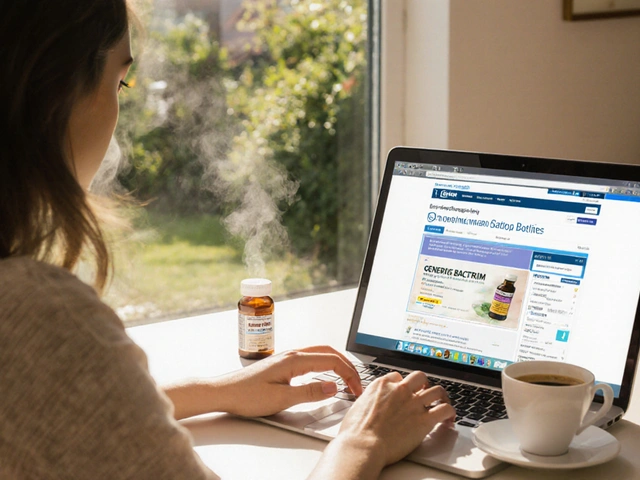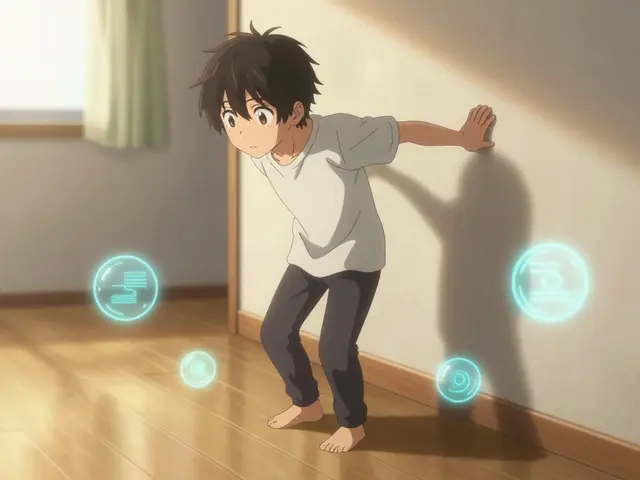Ever noticed how your shoulder or hip flares right when life gets loud-deadlines, family drama, or a rough sleep week? That’s not bad luck. Stress changes how your body processes pain and inflammation, so bursitis can feel sharper and stick around longer during stressful periods. Good news: you don’t need a spa week to break the cycle. You need a steady plan that lowers both tissue irritation and your body’s stress load.
This guide gives you a clear picture of the link, day-to-day tactics that actually fit real life, and a practical four-week plan you can adjust on busy weeks, rest days, and during flare-ups. Expect steady progress-not overnight miracles.
- bursitis and stress influence each other: stress amps up inflammation, tension, and pain sensitivity; pain then drives more stress.
- Quick wins: 60-90 seconds of slow nasal breathing, 30-60 seconds of isometrics, heat before movement, ice only for short-term calming.
- 4-week plan: calm the flare, rebuild capacity, pace your day, sleep smarter, and keep stress tools on a short leash (2-5 minutes, often).
- See a clinician if you have red flags (fever, major swelling, night pain that won’t settle) or if you’re stuck after 2-4 weeks.
- In Australia, first-line care is activity modification, targeted exercise, and short courses of anti-inflammatories if safe; imaging is rarely needed early.
The real link between bursitis and stress (and what to do about it)
Bursae are small fluid-filled cushions that reduce friction between tendons, muscles, and bones. When they’re irritated-often by overload, poor movement mechanics, or a sudden spike in activity-you get bursitis. Pain, stiffness, and tenderness near the joint show up first. Stress doesn’t “cause” bursitis the way a fall does, but it makes the fire burn hotter and longer.
Here’s the short version of the biology: stress hormones (like cortisol and adrenaline) shift your body toward a high-alert state. That nudges pro-inflammatory signaling, tightens muscles, raises resting heart rate, and messes with sleep. Your nervous system becomes more reactive, so normal signals feel more painful. That’s why a run-of-the-mill flare feels worse during a chaotic week.
| Stress effect | What it does to bursitis | What helps (fast) |
|---|---|---|
| Higher cortisol and sympathetic drive | Amplifies inflammatory signaling and pain sensitivity | 2-5 minutes slow nasal breathing; short walk; brief heat |
| Muscle guarding and shallow breathing | Extra compression and friction over a bursa | 30-60s isometric holds; gentle range work; posture micro-breaks |
| Sleep disruption | Lower pain threshold the next day, slower recovery | Wind-down alarms; 10-15 min earlier lights-out; consistent wake time |
| Catastrophising ("this will never heal") | More tension, avoidance, deconditioning | Reframe: "temporary irritation, not damage"; graded activity plan |
Evidence snapshot:
- Experimental sleep restriction consistently lowers pain tolerance and increases next-day pain sensitivity; that’s one reason flare-ups feel worse after bad nights (Sleep Health Foundation summaries; multiple lab studies).
- Isometric exercise can provide a short-term analgesic effect in tendon-related pain (e.g., Rio et al., 2015, patellar tendinopathy); this often translates well to bursitis-adjacent tendons.
- For common shoulder bursitis, specific exercise and load management are first-line; imaging is rarely needed early unless red flags are present (RACGP shoulder pain guidance; physiotherapy consensus).
“Pain is a biopsychosocial experience. Biological tissues matter, but so do mood, sleep, stress, and context.” - The Lancet Pain Series
What does this mean for your day? Treat both sides of the loop: soothe the irritated tissues and drop the stress load that keeps the loop spinning. That’s how you shorten flare-ups and stretch the pain-free windows.

Your 4-week plan to manage bursitis and stress-without quitting life
Use this as a template. Adjust reps and minutes based on your joint (shoulder, hip, knee, heel) and your week. If pain spikes above 6/10 or lingers past a day, dial back by 20-30% the next session.
First, a quick decision rule:
- If your joint is hot, red, or you have fever or unexplained severe night pain: stop and speak to a clinician soon (possible infection or crystal arthropathy).
- If pain is moderate, movement feels stiff but safe: continue with reduced load and the plan below.
- If you just finished a high-load day (big workout, long gardening session): plan a lighter next day and extra recovery tools.
What to aim for most days:
- Breathing reset (2-5 minutes): Inhale through the nose 4 seconds, exhale 6 seconds. Shoulders down. One hand on chest, one on belly. This dampens stress signals and eases muscle guarding.
- Isometric holds (3-5 rounds, 30-45 seconds each): Choose the version for your joint. Keep pain between 0-3/10.
- Shoulder (subacromial): standing isometric external rotation with a towel at your side; gentle wall press at different angles.
- Hip (trochanteric): side-lying hip abduction hold with a light band; standing wall push with the affected leg closest to the wall.
- Knee (prepatellar/pes anserine): quad set (knee straight, tighten thigh); wall sit at a pain-free angle.
- Heel (retrocalcaneal): isometric calf raise hold at mid-range, then slow lower.
- Range and glide (3-8 minutes): Slow, controlled arcs through pain-free to mildly uncomfortable range. Think 5-10 reps, two or three sets.
- Heat before, cool after: 10 minutes of gentle heat to loosen; optional 5-10 minutes of ice post-activity if you like the calming effect.
- Activity pacing: Break big tasks into 20-40 minute blocks. Micro-breaks: 60-90 seconds of movement or breathing between blocks.
Weekly rhythm (Weeks 1-4):
- Week 1: Calm the flare. Prioritise isometrics and range. Keep walking or cycling easy. Two 5-minute stress resets daily.
- Week 2: Build tolerance. Add gentle isotonic work (light band or bodyweight) 2-3 days. Keep breathing and sleep consistency.
- Week 3: Add capacity. Progress resistance slightly; extend walks or low-impact cardio by 10-15%. Introduce light, pain-free technique drills for your sport/work tasks.
- Week 4: Consolidate. Maintain gains, trial slightly longer sessions, and test a “busy day simulation” with planned micro-breaks and recovery.
Sample exercise progressions (adjust load to stay under 4/10 pain during and after):
- Shoulder: isometric external rotation → banded external rotation (2-3 sets x 10-12) → scaption with light dumbbells → wall slides and serratus work.
- Hip: side-lying abduction isometrics → clam shells (2-3 x 12-15) → standing hip hikers → lateral band walks.
- Knee: quad sets → mini squats (pain-free depth) → step-ups (low step) → controlled lunges.
- Heel: isometric calf raise → slow calf raises (bent and straight knee) → eccentric lowering off a step (as tolerated).
Load-management rules of thumb:
- Change one variable at a time: reps or weight or frequency, not all three at once.
- 10-20% weekly increase is plenty in the first month.
- A good session leaves you feeling looser 30 minutes later and the next morning. If you feel worse both times, that dose was too high.
Stress tools that stick (and don’t eat your day):
- Breath bookends: 2-5 minutes after waking, 2-5 minutes before bed. If you skip everything else, keep these.
- “Red light” reset: Every time you wait at a light or kettle boils, do one slow exhale set (6-8 seconds out, 4 seconds in).
- PMR (progressive muscle relaxation) around the sore joint: tense for 5 seconds, release for 10. Do 3-4 nearby muscle groups.
- Mindset nudge: Write one sentence: “This is irritation, not permanent damage.” It reduces threat in the nervous system.
- Nature micro-dose: 5-10 minutes outside, no phone, notice three sounds and three colours. Lowers arousal quickly.
Sleep tweaks that matter within a week:
- Keep wake-up time fixed (yes, even weekends in this phase).
- Move caffeine to before midday; aim for a 7-hour sleep window minimum.
- Nix doomscrolling: put the phone to sleep 60 minutes before you do; use a boring paperback or a podcast.
- Positioning: side sleepers with hip bursitis-stack pillows between the knees; shoulder bursitis-hug a pillow so your arm is supported and not pulled forward.
Pain relief options (use thoughtfully):
- Topicals (diclofenac/ibuprofen gels) can be helpful with fewer systemic effects. Test small areas first.
- Short courses of oral NSAIDs may reduce pain if you’re medically suitable; check with your GP, especially if you have kidney, gut, heart issues, or take blood thinners.
- Heat pre-activity tends to help mobility; ice post-activity can calm symptoms. Choose what feels best; neither “heals,” they modulate symptoms.
- Corticosteroid injections can provide short-term relief for stubborn bursitis but benefits may fade by 6-12 weeks; best paired with a progressive loading program (RACGP guidance; clinical trials).
Work and sport edits that lower friction on the bursa:
- Desk set-up: keep elbows close, keyboard low and flat, screen at eye level. Stand or move 2-3 minutes every 30-45 minutes.
- Shoulder-heavy tasks: switch to a step stool instead of repeated overhead reaching; use two lighter loads instead of one heavy lift.
- Hip bursitis: avoid crossing legs and long side-lying on the sore side; choose softer, cushioned surfaces for walking early on.
- Runners: trade a hard tempo for a technique session (cadence up 5-7%, shorter stride) during a flare; swap hills for flats until symptoms cool.

Checklists, FAQs, and what to do when things go sideways
Flare-up first aid (15-30 minutes total):
- Pause the aggravator (lift, reach, hill, long sit).
- Apply gentle heat for 10 minutes; breathe 4-6 for two minutes.
- Run 3-4 isometric holds (30-45 seconds) in a pain-relieving position.
- Switch task or reduce intensity to 60-70% for the next 24-48 hours.
- Optional: short ice session (5-10 minutes) if it calms you, then a 10-15 minute walk.
Daily mini-checklist (takes 5-10 minutes):
- Did I do two minutes of breathing on waking and before bed?
- Did I do 3-5 isometric holds and a little range work?
- Did I break one long task into two chunks?
- Did I move for at least 10 minutes outside?
- Did I set a consistent lights-out time?
When to seek care soon:
- Hot, red, very tender joint with fever or feeling unwell (rule out infection).
- Rapidly worsening swelling or pain after a fall.
- Night pain that wakes you and doesn’t settle with position changes.
- Numbness, weakness, or loss of function (e.g., can’t lift the arm at all).
Mini-FAQ
- Can stress cause bursitis by itself? Not usually. It’s more accurate to say stress makes you more vulnerable to overload and increases pain sensitivity. Address both and your symptoms ease faster.
- Do I need a scan? Often, no. In early, straightforward cases, imaging rarely changes first-line treatment (load management and exercise). Scans can be helpful if red flags, traumatic injury, or failure to progress after a few weeks.
- How long does this take to settle? Many cases improve within 2-6 weeks with steady, graded care. Stubborn cases need 8-12 weeks. Progress is rarely linear-expect two steps forward, one back.
- Is “no pain” the goal during exercises? Aim for tolerable symptoms (0-3/10) that settle within 24 hours. Zero pain is not required to heal.
- Should I stop all activity? No. Total rest slows recovery. Modify intensity, range, and frequency, but keep moving.
- What about supplements? Omega-3s and turmeric have mixed evidence for general inflammatory pain; if you try them, check interactions, especially with blood thinners.
- Will an injection fix it? It may break a pain loop and allow better rehab, but lasting results come from load management and strength.
Simple self-test to spot stress-driven flares:
- Did your pain spike during a high-stress week without a big change in physical load? Likely a stress-amplified flare.
- Do two minutes of breathing drop your pain by at least one point? Your nervous system is playing a big role-keep the stress tools front and centre.
Real-life example (Adelaide workday): Morning school run, tight shoulder. Before opening the laptop, you do 3 isometric holds against the wall, 90 seconds of breathing, and a hot shower. You work in 35-minute blocks and stand for calls. At lunch, a 12-minute walk in the park, then gentle band work for the shoulder. By late afternoon, you feel looser instead of locked up.
Common pitfalls to avoid:
- Doing all the things on Sunday, then nothing midweek. Your tissues prefer small, frequent nudges.
- Pushing through sharp pain and “earning” a three-day flare. Keep it at or under 4/10.
- Skipping sleep because you’re “catching up.” Pain thresholds nosedive after short nights.
- Chasing quick fixes without building strength. Relief opens the window; strength keeps it open.
If you’re stuck after 2-4 weeks:
- Review your log: Where did you spike load-long drives, overhead chores, hills, side sleeping?
- Trim intensity by 20% for a week, keep the frequency. Add one extra stress reset daily.
- Book a physiotherapy review for exercise refinement and load testing. In Australia, many clinics offer short appointments that fit a lunch break.
- Ask your GP about short-term medication options or whether an injection is appropriate based on your history.
Useful Australian context:
- RACGP and Australian Physiotherapy Association emphasise education, activity modification, and progressive loading as first-line treatment for most non-traumatic bursitis presentations.
- For mental health support tied to persistent pain, services like Beyond Blue and Head to Health provide resources you can access without a referral.
You don’t have to white-knuckle your way through this. Pair tissue-calming moves with bite-size stress resets, protect your sleep like a precious thing, and let strength rebuild your margin. That’s how you turn a loud, grumpy joint into a quieter one-even on a busy week.









Chris Jahmil Ignacio
The author thinks this is some kind of holistic miracle cure but let me tell you something the real issue is pharmaceutical companies suppressing natural anti-inflammatories like turmeric and CBD because they cant patent them and make billions off NSAIDs and steroid injections. You want real relief? Stop trusting the system. Your body knows how to heal itself if you stop poisoning it with chemicals and start listening to ancient wisdom. This plan is just another corporate wellness scam wrapped in sciencey jargon.
Colin Mitchell
I love this breakdown. So many people think pain is just a physical thing but the stress-pain loop is real and often ignored. I’ve had hip bursitis for years and the breathing resets and isometrics made a bigger difference than any cortisone shot. The 2-minute morning/evening breaths? Non-negotiable for me now. Even on chaotic days I do them while waiting for coffee. Tiny habits, huge payoff. Keep it simple and consistent.
Josh Bilskemper
This guide is cute but fundamentally flawed. You mention isometrics and load management like they’re revolutionary when they’ve been standard physio for decades. The real problem is people who think they can self-diagnose bursitis from a Reddit post then skip imaging entirely. That’s dangerous. And calling cortisol a stress hormone? That’s basic endocrinology 101. You’re not teaching anything new you’re just repackaging textbook knowledge with trendy phrasing. If you want to help people stop pretending you’re the first person to figure this out.
Storz Vonderheide
As someone who’s lived with chronic shoulder bursitis for 8 years and moved from the US to Australia I can say this plan is one of the most balanced I’ve seen. The RACGP references are spot on and the pacing advice? Life-changing. I used to do all my rehab on weekends then crash. Now I do 3 minutes of breathing after every Zoom call and it adds up. Also the sleep positioning tip for side sleepers? I wish I’d known that five years ago. You don’t need to overhaul your life just tweak it smartly. This isn’t magic it’s medicine with mindfulness.
dan koz
Bro you forgot one thing. In Nigeria we call this kind of pain "spiritual pressure" and we use ginger tea and prayer. But honestly your breathing and isometrics work too. I tried both. The breathing calms my mind the isometrics stop my hip from screaming. You don’t need to choose between science and tradition. Use what works. Also no phone before bed? That’s the secret. My cousin stopped waking up with pain after he stopped scrolling at 11pm. Simple.
Kevin Estrada
OMG I JUST REALIZED MY BURSITIS GOT WORSE EVERY TIME I HAD A FIGHT WITH MY MOM AND I NEVER CONNECTED IT. I WAS DOING ALL THE EXERCISES BUT STILL IN PAIN BECAUSE I WAS LIVING IN CHAOS. THIS POST CHANGED MY LIFE. I STARTED DOING THE BREATHING BEFORE I TEXTED MY EX AND NOW I’M NOT CRYING IN THE BATHROOM AT 2AM. I’M NOT THE SAME PERSON. I’M A NEW ME. I’M A BURSITIS WARRIOR. THANK YOU.
Katey Korzenietz
Isometrics for bursitis? Really? That’s from Rio 2015 which was on tendinopathy not bursitis. You’re conflating two different pathologies. And sleep restriction lowering pain threshold? That’s lab data not clinical reality. Most people don’t get 5 hours sleep because they’re busy not because they’re stressed. This is pseudoscience dressed up as practical advice. And you didn’t even mention NSAID risks properly. Amateur hour.
Susan Haboustak
Of course you’re telling people to avoid imaging. That’s what every non-specialist does when they’re afraid of missing something serious. You say red flags mean see a clinician but then you give a 4-week self-guided plan that assumes they won’t. This is dangerous. People with infection or cancer masquerading as bursitis will read this and delay care. You’re not helping you’re enabling. And calling it "stress-amplified" instead of "psychosomatic" is just semantic avoidance. Pain is pain. Stop pretending you’re not treating the mind with a body-focused guide.